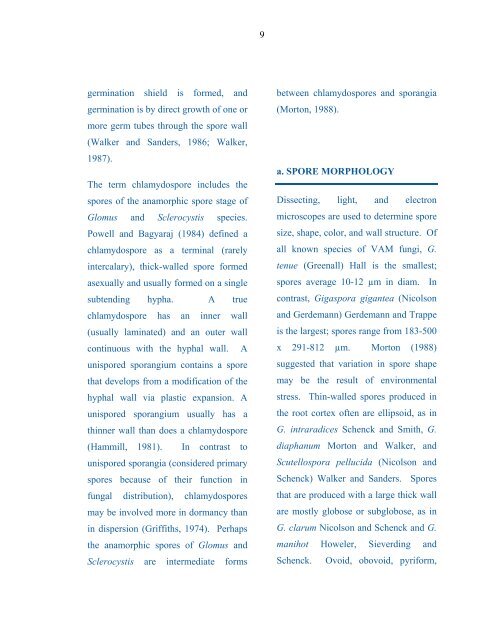Taxonomy and Ecology Of Inland Sand Dune ... - Mycorrhizae
Taxonomy and Ecology Of Inland Sand Dune ... - Mycorrhizae
Taxonomy and Ecology Of Inland Sand Dune ... - Mycorrhizae
Create successful ePaper yourself
Turn your PDF publications into a flip-book with our unique Google optimized e-Paper software.
9germination shield is formed, <strong>and</strong>germination is by direct growth of one ormore germ tubes through the spore wall(Walker <strong>and</strong> S<strong>and</strong>ers, 1986; Walker,1987).The term chlamydospore includes thespores of the anamorphic spore stage ofGlomus <strong>and</strong> Sclerocystis species.Powell <strong>and</strong> Bagyaraj (1984) defined achlamydospore as a terminal (rarelyintercalary), thick-walled spore formedasexually <strong>and</strong> usually formed on a singlesubtending hypha. A truechlamydospore has an inner wall(usually laminated) <strong>and</strong> an outer wallcontinuous with the hyphal wall. Aunispored sporangium contains a sporethat develops from a modification of thehyphal wall via plastic expansion. Aunispored sporangium usually has athinner wall than does a chlamydospore(Hammill, 1981). In contrast tounispored sporangia (considered primaryspores because of their function infungal distribution), chlamydosporesmay be involved more in dormancy thanin dispersion (Griffiths, 1974). Perhapsthe anamorphic spores of Glomus <strong>and</strong>Sclerocystis are intermediate formsbetween chlamydospores <strong>and</strong> sporangia(Morton, 1988).a. SPORE MORPHOLOGYDissecting, light, <strong>and</strong> electronmicroscopes are used to determine sporesize, shape, color, <strong>and</strong> wall structure. <strong>Of</strong>all known species of VAM fungi, G.tenue (Greenall) Hall is the smallest;spores average 10-12 µm in diam. Incontrast, Gigaspora gigantea (Nicolson<strong>and</strong> Gerdemann) Gerdemann <strong>and</strong> Trappeis the largest; spores range from 183-500x 291-812 µm. Morton (1988)suggested that variation in spore shapemay be the result of environmentalstress. Thin-walled spores produced inthe root cortex often are ellipsoid, as inG. intraradices Schenck <strong>and</strong> Smith, G.diaphanum Morton <strong>and</strong> Walker, <strong>and</strong>Scutellospora pellucida (Nicolson <strong>and</strong>Schenck) Walker <strong>and</strong> S<strong>and</strong>ers. Sporesthat are produced with a large thick wallare mostly globose or subglobose, as inG. clarum Nicolson <strong>and</strong> Schenck <strong>and</strong> G.manihot Howeler, Sieverding <strong>and</strong>Schenck. Ovoid, obovoid, pyriform,


